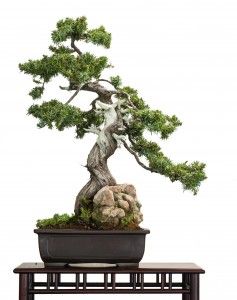 Cascade Style is one of the most popular bonsai styles used today. If you can picture a tree growing on the side of a cliff, spilling off the mountain, this is what cascade is meant to mimic. You typically see this bonsai in a tall skinny pot that is used to raise the bonsai off the ground to give it room to cascade. This pot shape is also helpful to support deeper roots that can help keep the tree in the pot.
Cascade Style is one of the most popular bonsai styles used today. If you can picture a tree growing on the side of a cliff, spilling off the mountain, this is what cascade is meant to mimic. You typically see this bonsai in a tall skinny pot that is used to raise the bonsai off the ground to give it room to cascade. This pot shape is also helpful to support deeper roots that can help keep the tree in the pot.
For a bonsai to be a true cascade bonsai, the apex of the tree must fall below the base of the pot. You can follow the base of the tree out of the soil and then it will almost immediately start to drop towards the ground. The branches of the tree should grow horizontal from the trunk to maintain some balance as it grows downwards. The branches will typically alternate sides, left to right, on the way down to make is look more natural as well.
Best Species For Cascade Bonsai
Some tree species are better fit for this style than others. Juniper and Cotoneaster are the two most popularly used to develop cascade bonsai because of their natural tendencies. Both of these species naturally grow close to the ground and are commonly used as ground cover. With a little wiring, you can easily train both of these species into cascade bonsai.
Other trees that are used to make great specimen cascade bonsai are Japanese Black and White pines, Mountain Pine, and Scotch Pine. Pine’s are typically best for this style, but with some extra work, just about any species can be used. If you are ambitious and use a broadleaf species, make sure that the sun is not beaming on the undersides of the leaves.
How to Cascade Your Bonsai
It is best to start this process is early spring while the branches are the softest. Clean all dead wood and foliage out so that you have a clean tree to work with. You may want to trim about half of the branches off of the tree. Start with the smaller branches first, then see how it looks after those are removed. After that, decide where you want to apex of the tree to end up.
Once you have that figured out, you can start wiring the truck and branches into the desired shape. You may have to double the wire to get the right amount of bend since bending downward is not easy. Start by anchoring the wire to the trunk and then move your way up the entire trunk. With the trunk wired up tight, you can bend the tree in the desired shape.



